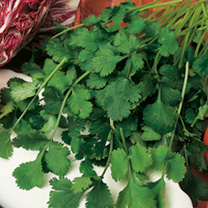How to Grow Coriander – A Guide to Growing Coriander
 Coriander is a popular herb, especially for its use in curries.
Coriander is a popular herb, especially for its use in curries.
Coriander needs to be grown in a deep pot or better still in a deep bed due to it having a long tap root.
Varieties of Coriander
Some varieties of Coriander are bred not to bolt (they don’t produce flowers and seed), others are bred more for the seeds, and some are dual-purpose. It is best to check the description when buying seeds so you get the right variety .
There new are varieties that are bred as ‘cut and come again’. Calypso and Confetti are two of these and they can be cropped three times before the plants are exhausted.
There is also a new variety – Coriander cress – it is a wild coriander with small leaves and is a type of micro-green rather than a variety of cress. Coriander cress has an aromatic citrus like flavour.
Pests and Problems with Coriander
If your Coriander plant has poor growth, or the leaves are turning yellow, a feed with a general purpose liquid fertilizer is needed .
Coriander is otherwise generally problem free.
Sowing & Growing Coriander
- Coriander needs to be sown directly into its final growing position – Coriander does not take well to being transplanted due to its long tap root .
- Apart from the ‘cut and come again’ and ‘cress’ varieties Coriander is best sown every three weeks or so between March and September.
- A sunny and hot position is needed if you are growing Coriander for the seeds and a spot in partial shade if you don’t want the plants to produce seed.
- You will need to pick off any flowers as soon as you see them if you growing for the leaves .
- The plants need to be protected with cloches in cold weather.
- Coriander cress comes in a prepack tray ready for growing.
Harvesting Coriander
Harvest May–October.
Harvest leaves as soon as they are ready if growing for the leaves .
If growing for the seeds, you need to wait until the flower heads have died back then place them upside down in a paper bag in a cool, dry place. After a few weeks or so give the bag a good shake so the seeds fall into the bag.
Eating & Storing
Both the Coriander seeds and leaves can be used in cooking .
Although mainly used in curries you can add coriander to soups, salads and use with barbequed meat, fish and vegetables. It has a distinctive flavour which will enhance many dishes and is often used as an interesting alternative to parsley .
Try Coriander in salsa or with chillies .
Coriander leaves can be cut and stored in a plastic bag in the fridge for up to 2 weeks. They can be chopped and frozen with a little water in ice cubes, they can also be dried for later use.
Coriander seeds should be dried and kept in a sealed container away from light and heat. The flavour will begin to diminish after about 6 months and they are best used within 1 year.
Coriander cress goes well with curries, salads, tomatoes and chicken. It can also be used as a garnish to give Mexican food a delicious bite.
Further Information on Coriander
Coriander Seeds from the Allotment Shop
Check out the Allotment Seed Shop for great value seeds.
Germination & Quality Checked for consistent results



